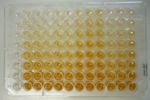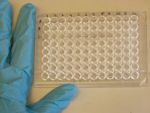ELISA testing
Introduction
The Enzyme Linked Immunosorbent Assay (ELISA) is an immunoassay commonly used to detect the presence of an antigen or antibody in a sample. It is a powerful tool in clinical immunology and can be used to determine whether an individual has been exposed to a specified pathogen. Utilising the principle of antigen-antibody interaction, the test allows easy visualisation of results and, since its introduction in 1971, has quickly replaced radioimmunoassays for diagnostic purposes.
- There are two basic types of ELISA:
- Homogenous- completed in one step, all reagents added simultaneously. Primarily used to detect small molecules such as digoxin and gentamicin
- Heterogenous- various reagents added sequentially, primarily used to detect microbial antigens and antibodies
This article describes the heterogenous type
Applications
- Detection and identification of disease agents, e.g. type and subtype
- Identification of specific antibodies, e.g. used in serodiagnosis for epidemiological studies
- Quantification of specific antibody isotypes, e.g. IgM/IgG ratio
Techniques
There are many methods of ELISA, but each assay involves these basic steps:
- The adsorption of antibody/antigen to solid phase (the medium)
- The addition of the chosen sample and reagents
- Incubation and washing
- The addition of enzyme-labeled antigen/antibody
- The addition of a specific substrate
Competitive VS Non-competitive
- As their name implies, competitive assays measure the competition between a pre-titrated (fixed amount) of labeled antigen and an unknown quantity of sample antigen in their affinity to an antibody. The process can be reversed to measure the competition between labeled and unlabeled antibody.
- Competitive techniques:
- Easier to quantify
- Less likely to be influenced by contaminants
- However they are more demanding with regard to the accuracy of the reagents and the purity of the labeled ligand
- Non-competitive assays:
- Errors in dispensing reagents have little effect on the result
- Therefore they are easier to control and yield accurate results
- However they are easily influenced by cross reactions and non-specific binding
Solid VS Fluid-phase
An important consideration is the medium in which the assay is carried out, largely dependent on what is being tested:
- Fluid-phase (in solution)
- Main advantage is that the behaviour of molecules in solution is easier to predict
- Solid-phase (surface of protein-binding material, e.g. plastic)
- Easier to perform and more sensitive
- The most widely used solid-phase is the 96-well microtiter plater, manufactured as PVC flexible plates or polystyrene rigid plates
Non-competitive ELISA
Double Antibody Sandwich (for antigen detection)
- Antibody is adsorbed onto solid phase
- Wash
- Sample serum is added- specific antigen binds to antibody
- Wash
- Enzyme-labeled specific antibody is added- attaches to bound antigen
- Wash
- Enzyme substrate is added (with dye for visualisation)
visualised product = amount of antigen in the serum
Antibody Class Capture Assay (for antibody detection)
- Class-specific antiglobulin is adsorbed onto solid phase
- Wash
- Sample serum is added- class-specific antibody in the serum binds to antiglobulin
- Wash
- Antigen is added - attaches to specific antibody
- Wash
- Enzyme-labeled antibody is added
- Wash
- Enzyme substrate is added
visualised product = amount of specific antibody in serum
Indirect Method (for antibody detection)
- Specific antigen (i.e. not from sample) is adsorbed onto solid phase
- Wash
- Serum is added- any specific antibody present in sample binds to antigen
- Wash
- Enzyme-labeled antiglobulin is added- attaches to antibody
- Wash
- Enzyme substrate is added
visualised product = amount of antibody in the serum
Competitive ELISA
Direct Antibody Competition (for antibody detection)
- Antigen is adsorbed onto solid phase
- Wash
- Enzyme-labeled antibody (pre-titrated- optimal colour development) and serum are added
- Wash
- Enzyme substrate is added
visualised product = amount of antigen in serum sample
Direct Antigen Competition (for antigen detection)
- Antigen is adsorbed onto solid phase
- Wash
- Antigen in serum is incubated with enzyme-labelled antibody (again pre-titrated): this is directed against the antigen on the solid phase
- Wash
- Enzyme substrate is added
visualised product = amount of enzyme-labelled antigen
| This article has been peer reviewed but is awaiting expert review. If you would like to help with this, please see more information about expert reviewing. |
| Originally funded by the RVC Jim Bee Award 2007 |


